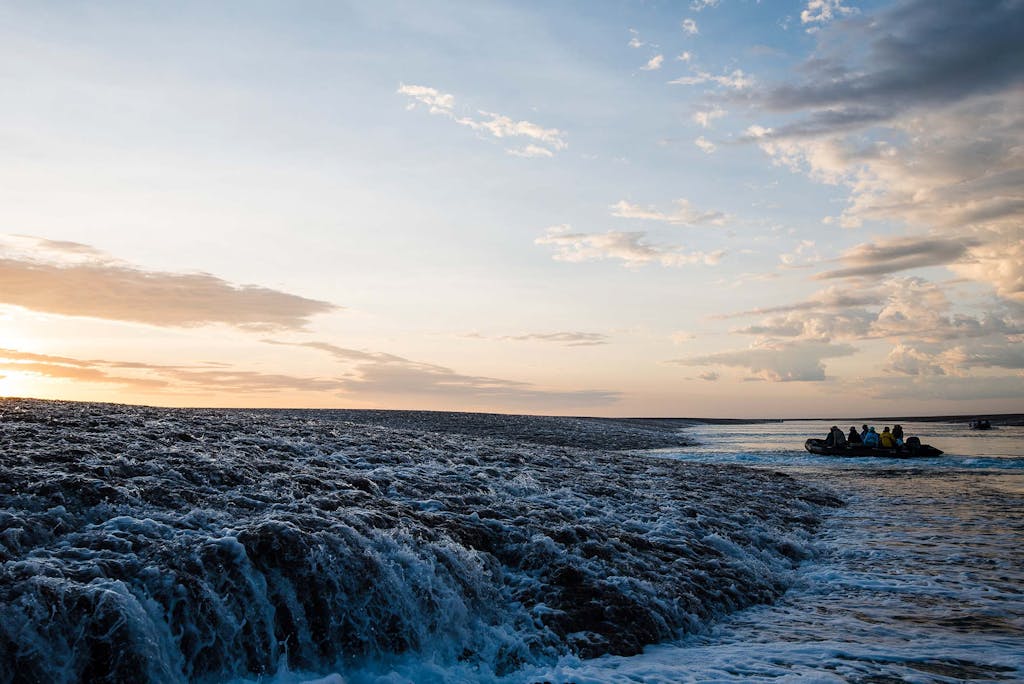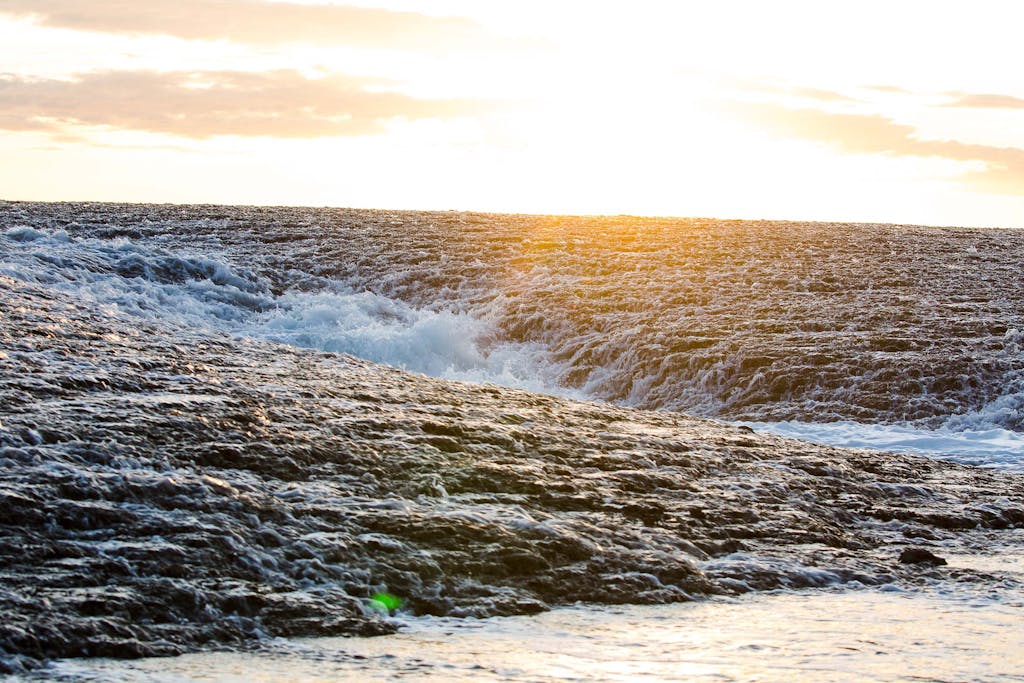The Kimberley’s Montgomery Reef Rides With the Tide
“Get ready to see something really special,” says our Brad Siviour, our expedition leader, as we step down, one by one, from the gangway into the Zodiac to explore Montgomery Reef.
The sun is high in the cobalt sky on this early April afternoon in the Kimberley region of Western Australia. Dainty White-winged Terns hover overhead, carefully picking out their next meal from the glassy water. Nothing but open sea is visible for miles, save a handful of isolated islands to the northeast.
The Zodiacs maneuver away from the ship. Then, in the haze of the afternoon sun, I see something phenomenal: The land is rising from the water. “What you are experiencing is not a mirage,” Siviour says, beaming. He is clearly as thrilled to be here as we are. “It is not land, either. This is Montgomery Reef – a 400-square-kilometer marine ecosystem becoming exposed as the tide drops.”
There’s a reason day trips to Montgomery Reef are among the most intriguing cruise excursions in Australia. Even the most seasoned travelers can’t help but grin with childlike wonder when they witness this unique phenomenon and recognize this is one of the best things to do in Western Australia.

One of the greatest natural wonders of Australia … and the world
Sir David Attenborough describes Montgomery Reef, a huge coral reef, situated approximately 9.3 miles (15 kilometers) from the Kimberley coastline, as “one of the greatest natural wonders of the world.”
The Zodiacs continue into a long waterway that Siviour calls “The River” — a channel carved from the reef over time. As the huge mass becomes more exposed, seawater begins to gush over the sides and into it. The effect is like being surrounded by hundreds of mini-waterfalls. We look on awestruck by the abundance of natural beauty.
We notice gentle ripples appearing in the water around us, and Siviour stops the Zodiac and turns off the engine. The sea is still for a moment. Suddenly, a tiny brown head pops up to take a breath. Then another one. Then green sea turtles surround us. We soon realize there are hundreds of bobbing heads along the channel. The wildlife in Australian coral reefs is world-famous, but Montgomery Reef is, again, something to behold.
On the reef, scores of egrets are poised, ready to grab a mouthful of food. Siviour points out the White-bellied Sea Eagle soaring above us. This magnificent bird of prey is also on the lookout for exposed fish and crustaceans. Besides these avian companions, the whole place feels wild and isolated.

The forceful power of the tides
As it’s approaching a full moon in the Kimberley, the tidal variation is significant, just as it is when nearing a new moon. During a full moon, a so-called “spring tide” can rise and fall by nearly 34.5 feet (10.5 meters) in just 12 hours.
In the days between the full and new moon, the tidal change is at its smallest with a difference of approximately 13 feet (4 meters). Regardless of the calendar timing, twice a day at low tide a significant amount of reef is left exposed to the elements, including the scorching hot Australian sun.
Today, it means hard and soft corals are out of the water. I wonder what this means for creatures such as sea turtles, epaulette sharks and the migratory birds, who depend on this ecosystem to live and feed.
“It is amazing to see reef animals endure this highly dynamic environment,” says Lea McQuillan, a marine biologist and Silversea expedition team member. “Corals that were once under meters of water are suddenly exposed to the intense tropical sun. As a result, they have evolved to be quite hardy. They have adapted to survive being exposed to the air and the sun’s rays.”
Incredibly, some corals have developed the ability to secrete a mucus-like substance over themselves to prevent drying out when exposed to the air. The substance is also said to act as a natural sunscreen to protect cell membranes within the animal from the harsh ultraviolet radiation.
This adaptation allows the coral species to thrive in hugely varying tides and a dry, scorching environment where others would perish. As a result, the coral reef stays healthy, so wildlife can continue living and feeding successfully.

The ecosystem of Montgomery Reef in the Kimberley
Although Montgomery Reef’s ecosystem can survive the large tidal ranges of the region, it is, like all coral, particularly sensitive to changes in light and temperature that can cause bleaching. This was a reality four years ago while McQuillan was working in the region.
“I was under the impression that Montgomery Reef was so isolated and remote, so special that it would never be influenced by anything,” she says. “You can imagine how disappointed I was to see the soft leather corals bleached.”
Whether affected by climate change or the periodic warming of ocean waters because of El Niño, some corals can recover after bleaching. But many die, resulting in a loss of habitat for those marine critters living and feeding around it.
“At that time we had an El Niño year, and 80 percent of the world’s coral reefs had been bleached,” McQuillan recalls.
As I listen to Expedition Team members talk passionately about this place, I am increasingly aware that it is a privilege to witness this unique and diverse marine habitat firsthand. And observing it in person on Montgomery Reef day tours with Silversea raises awareness about how fragile it is.
Experts feel the same way. “Personally,” McQuillan says, summing up my feelings, “Montgomery Reef offers me a new experience every time we visit. I turn a corner, and I never know what wildlife will be there to greet me.” Learn about the history of the Bungle Bungle range in the Kimberley.
Ready to investigate one of the best things to do in Western Australia? Get started here.

Editor’s Note: Montgomery Reef is part of the Buccaneer Archipelago, visited by Silversea on expedition voyages to the Kimberley region of Australia.
